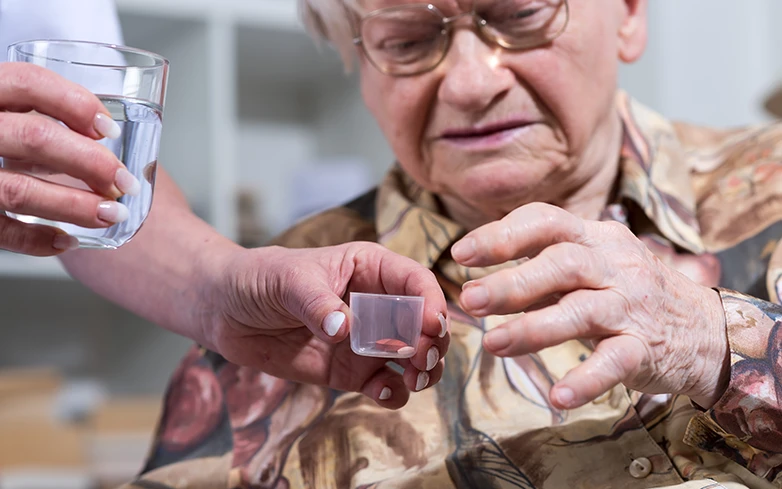From AARP —
By Emily Paulin–
Eight in 10 elderly nursing home residents on Medicare were prescribed psychiatric drugs during a recent nine-year period, a new government report has found. That’s roughly a million residents per year.
The report, released last week by the Department of Health and Human Services’ Office of the Inspector General, suggests that yearslong efforts to tamp down on inappropriate use of psychiatric drugs in U.S. nursing homes are failing.
The drugs, scientifically known as psychotropics, have long been criticized by nursing home resident advocates and lawmakers as “chemical straight jackets” used to sedate unsettled patients, particularly those with dementia. The psychiatric drugs include antianxiety agents, antidepressants, antipsychotics, anticonvulsants — which are often prescribed to epileptics — and other drugs that affect brain activity associated with mental processes and behavior.
About 80 percent of elderly long-stay Medicare residents nationwide — those age 65 and older and in a nursing home for 101 days or longer — were prescribed some type of psychiatric drug every year from 2011 to 2019, according to the report.
“We are deeply concerned for the residents that continue to face the inappropriate and dangerous use of these drugs,” said Kelly Bagby, vice president of litigation at AARP Foundation, which has sued nursing homes for incorrectly administering psychotropic drugs. “These drugs can have fatal consequences.”
She called the inspector general’s report “vitally important” but said “AARP Foundation is in no way surprised by the results.”
The use of psychotropic drugs in older adults often comes with serious side effects and risks including liver failure and increased risk of suicide.
A switch in psychiatric drugs
The study found that the Centers for Medicare & Medicaid Services (CMS), the federal agency that oversees nursing homes, reduced the use of one category of psychotropic drug over the study period: antipsychotics.
A decade ago, following the release of an inspector general’s report that shed light on the overuse of antipsychotics in nursing homes, CMS started collecting data on antipsychotic prescriptions in facilities. A few years later, the agency started incorporating each facility’s use of the drugs into its rating on the Nursing Home Five-Star Quality Rating System. CMS also issued more fines for inappropriate antipsychotic prescribing in nursing homes.
Those strategies appear to have worked, with antipsychotic drug use in nursing homes decreasing from 31 percent in 2011 to 22 percent in 2019, according to the new report.
But as antipsychotic use declined, another category of psychiatric drugs — anticonvulsants, typically used to treat epileptic seizures — surged, with the proportion of residents prescribed them jumping from 28 percent in 2011 to 40 percent in 2019. This growth left overall use of psychotropic drugs unchanged.
“Even though the government is taking action, the problem remains,” Brian Whitley, a regional inspector general for the Department of Health and Human Services and coauthor of the report, told AARP. “It’s just morphed, like a balloon — when you put pressure on one part of a balloon, the other part of the balloon gets bigger,” he added.
While antipsychotics have been its main focus, CMS has acknowledged that anticonvulsants and other psychotropic medications also carry major risks. It’s said that the use of other psychotropic medications “should not increase when efforts to decrease antipsychotic medications are being implemented.” And it stepped up penalties for nursing homes that needlessly prescribed psychotropic drugs, from 3,415 citations in 2011 to 4,321 citations in 2019, the report found. But overall use of all psychotropic drugs remained unchanged over that time.
“This report further indicates that nationwide efforts at provider education, along with current regulatory enforcement processes, have been largely ineffective in changing this dangerous practice,” said Jonathan Evans, a geriatrician and former head of Geriatric and Palliative Medicine at the University of Virginia, in a statement. “Clearly, a different approach is called for.”
Prescribing drugs to compensate for understaffing
Understaffed nursing homes have often been criticized for using psychiatric drugs as an alternative to hiring more staff to care for residents. The inspector general’s findings support that critique.
Analyzing data from 2019, the report found higher use of psychotropic drugs in nursing homes with lower levels of registered nurses (RNs). In facilities that had RNs on staff for 15 minutes or less per resident per day, 81 percent of residents had claims for psychotropic drugs. At nursing homes that had RNs on staff for more than one hour per resident per day, 75 percent of residents had claims for psychotropic drugs.
“Substituting inappropriate drugging for appropriate staffing is unacceptable,” Lori Smetanka, executive director for The National Consumer Voice for Quality Long-Term Care, said in a statement. “Sedation as a method of care management instead of investment in better pay and training to recruit and maintain safe staffing levels is further evidence many nursing home owners put profits over the well-being of residents in their care.”
CMS has proposed establishing a national minimum staffing requirement, which AARP supports, that could mandate certain amounts and types of care per resident in the nation’s nursing homes. But the specifics are not expected to be announced until spring, following a study to determine the level and type of staffing needed.
While Smetanka applauds the initiative, she’s “concerned about the slow implementation path” and has asked for a “fast-track” of the requirement.
The schizophrenia loophole
Another trend identified by the inspector general was an increase in the number of unsupported schizophrenia diagnoses among nursing home residents.
In 2015, when CMS began incorporating antipsychotic use into a facility’s Five-Star Quality Rating, it decided that three uncommon conditions — schizophrenia, Tourette’s syndroem and Huntington’s disease — would not be included in the tally. Because the drugs were approved to treat patients with those conditions, CMS decided that facilities shouldn’t be penalized for their use.
Since then, however, the number of residents reported as having schizophrenia, but who lack a corresponding schizophrenia diagnosis in their Medicare claims history, has skyrocketed. Between 2015 and 2019, it increased threefold, the report found. It also found that the unsupported reporting of schizophrenia was concentrated in 99 nursing homes in which 20 percent or more of the residents had a report of schizophrenia but no claims history.
In the general population, schizophrenia afflicts less than 1 percent of people and is typically diagnosed in the late teens years to early 30s, not later in life. “The concern is that nursing homes could misreport residents as having schizophrenia to falsely impact their [rating],” report lead Andrea Staples told AARP.
In response to the inspector general’s report, CMS said it is using data to analyze and evaluate the use of psychotropics and other drugs in nursing homes.
Emily Paulin is a contributing writer who covers nursing homes, health care, and federal and state policy for AARP.

